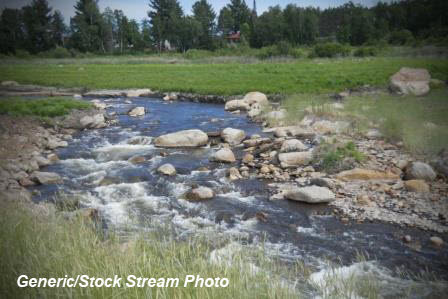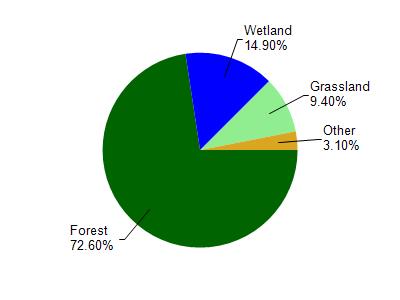
9.03 Miles
0 - 9.03
Cool-Cold Headwater, Coldwater
2021
Good
Bayfield, Douglas
No
No
No
Fish and Aquatic Life
Overview
Fish Creek in Orienta Township forms a small estuary with coastal wetlands where it meets Lake Superior. The Lake Superior shoreline adjacent to the river mouth consists of eroding scarps in unconsolidated sediments. The Lake Superior Binational Program identified this stream as important to the integrity of the Lake Superior ecosystem for coastal wetlands. The stream flows through a deep ravine and drains the red clay and nearly level pink sands region of northwest Bayfield County. Because the upper end drains a marshy area, water temperatures are high and water quality poor. Feeder streams improve temperatures in the middle stretch (T48N R10W S13), enabling the stream to support a small, native brook trout population. This favorable stretch extends about two and a half miles downstream before deteriorating. In dry weather, stream flows in this stretch fluctuate widely. The reach is inhabited only by minnows, with mudminnows, white suckers, longnose dace, northern creek chubs and sculpins predominating. Much of the upper reach is bordered by pastured upland and erosion problems have been serious. Water in the lower portions of the stream is usually quite turbid as a result.
During survey work conducted as part of the coastal wetlands evaluation, two rare species were found and overall taxa richness was moderate (5-24 species) (Epstein 1997). The survey noted that barnyards, cropland, streambank pasturing, failing septic systems and streambank erosion are potential pollutant sources.
From: Turville-Heitz, Meg. 1999. Lake Superior Basin Water Quality Management Plan. Wisconsin Department of Natural Resources, Madison, WI.
Date 1999
Author Aquatic Biologist
Condition
Wisconsin has over 84,000 miles of streams, 15,000 lakes and milllions of acres of wetlands. Assessing the condition of this vast amount of water is challenging. The state's water monitoring program uses a media-based, cross-program approach to analyze water condition. An updated monitoring strategy (2015-2020) is now available. Compliance with Clean Water Act fishable, swimmable standards are located in the Executive Summary of Water Condition in 2018. See also the 'monitoring and projects' tab.
Reports
Management Goals
Wisconsin's Water Quality Standards provide qualitative and quantitative goals for waters that are protective of Fishable, Swimmable conditions [Learn more]. Waters that do not meet water quality standards are considered impaired and restoration actions are planned and carried out until the water is once again fishable and swimmable
Management goals can include creation or implementation of a Total Maximum Daily Load analysis, a Nine Key Element Plan, or other restoration work, education and outreach and more. If specific recommendations exist for this water, they will be displayed below online.
Monitoring
Monitoring the condition of a river, stream, or lake includes gathering physical, chemical, biological, and habitat data. Comprehensive studies often gather all these parameters in great detail, while lighter assessment events will involve sampling physical, chemical and biological data such as macroinvertebrates. Aquatic macroinvertebrates and fish communities integrate watershed or catchment condition, providing great insight into overall ecosystem health. Chemical and habitat parameters tell researchers more about human induced problems including contaminated runoff, point source dischargers, or habitat issues that foster or limit the potential of aquatic communities to thrive in a given area. Wisconsin's Water Monitoring Strategy was recenty updated.
Grants and Management Projects
| Project Name (Click for Details) | Year Started |
|---|
|
|
Monitoring Projects
| WBIC | Official Waterbody Name | Station ID | Station Name | Earliest Fieldwork Date | Latest Fieldwork Date | View Station | View Data |
|---|
| 2871500 | Fish Creek | 10041752 | Fish (Oulu) Creek at CTH B | 1/1/2015 | 1/1/2015 | Map | Data |
| 2871500 | Fish Creek | 045014 | Fish Creek - Mouth | 4/3/2007 | 6/30/2021 | Map | Data |
| 2871500 | Fish Creek | 10012160 | Fish Creek - Upstream Old Hwy 13 Station1 | | | Map | Data |
| 2871500 | Fish Creek | 043196 | Fish Creek at Old Sth 13 | 10/24/2003 | 10/24/2003 | Map | Data |
|

Watershed Characteristics
Fish Creek is located in the Iron River watershed which is 213.39 mi². Land use in the watershed is primarily forest (72.60%), wetland (14.90%) and a mix of grassland (9.40%) and other uses (3.10%). This watershed has 300.83 stream miles, 5,975.89 lake acres and 7,470.27 wetland acres.
Nonpoint Source Characteristics
This watershed is ranked Not Ranked for runoff impacts on streams, Not Available for runoff impacts on lakes and Low for runoff impacts on groundwater and therefore has an overall rank of Low. This value can be used in ranking the watershed or individual waterbodies for grant funding under state and county programs.However, all waters are affected by diffuse pollutant sources regardless of initial water quality. Applications for specific runoff projects under state or county grant programs may be pursued. For more information, go to surface water program grants.
Fish (Oulu) Creek is considered a Cool-Cold Headwater, Coldwater under the state's Natural Community Determinations.
Natural communities (stream and lake natural communities) represent model results and DNR staff valiation processes that confirm or update predicted conditions based on flow and temperature modeling from historic and current landscape features and related variables. Predicated flow and temperatures for waters are associated predicated fish assemblages (communities). Biologists evaluate the model results against current survey data to determine if the modeled results are corect and whether biological indicators show water quaity degradation. This analysis is a core component of the state's resource management framework. Wisconsin's Riverine Natural Communities.
Cool (Cold-Transition) Headwaters are small, usually perennial streams with cold to cool summer temperatures. Coldwater fishes are common to uncommon (<10 per 100 m), transitional fishes are abundant to common, and warm water fishes are uncommon to absent. Headwater species are abundant to common, mainstem species are common to absent, and river species are absent.